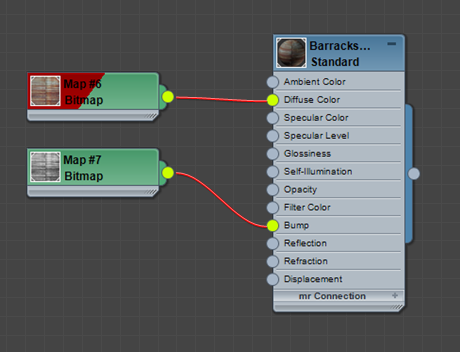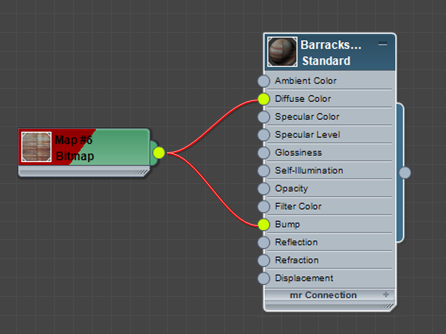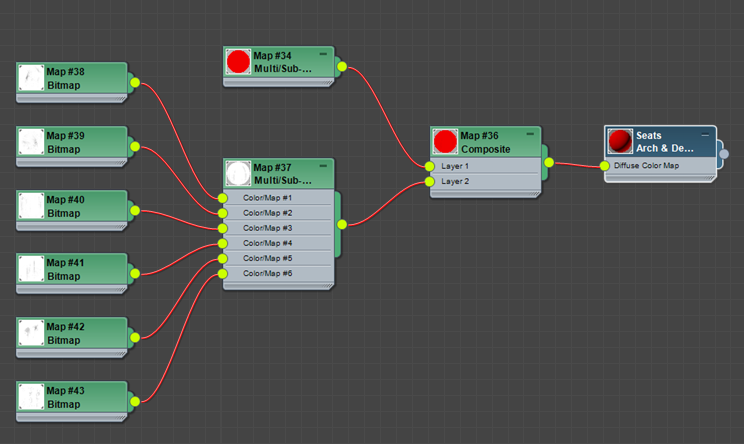To map a material component, you wire a map node to the input socket for that component’s slot. Drag from the map socket to the material socket or from the material socket to the map socket.
Play this to see how to wire a map:
![]() While the Select tool is active, you can select a wire by clicking it, just as you select a node. The selected wire turns white.
While the Select tool is active, you can select a wire by clicking it, just as you select a node. The selected wire turns white.
When you click the left half of a node and hold the mouse button, 3ds Max opens a context menu that lets you choose among the available input parameters. When you click the right side of a node and hold, the menu shows the available outputs. If you move the mouse without making a menu selection, the menu display goes away. This method can help you wire two nodes when the active View is zoomed out, and it is hard to pick individual sockets.
3ds Max gives you a great variety in the way you can combine maps, so the map tree as it appears in the view can take various forms.

A material with one map for diffuse color and another as the bump map

A material with a single map used as both diffuse color and bump maps
Some maps combine other maps, and some materials can combine sub-materials, so a material tree can have more than two levels.

A four-level tree that uses Multi/Sub maps and a Composite map
Procedures
To apply a map to a material component:
- Drag from the map’s output socket to the input socket of the material's component slot. See the movie at the beginning of this topic.
To remove a map or map connection, do one of the following:
- Select a map node, then click
 (Delete Selected) or press
(Delete Selected) or press  .
. - Select the wire between the map and the material, then delete it.
- Drag the wire away from a socket where it has been connected.
-
 Select an object, then in the MAXScript Listener, enter $.material.diffusemap=undefined (the names of the map components vary with the material type: See the MAXScript Help for details).
Select an object, then in the MAXScript Listener, enter $.material.diffusemap=undefined (the names of the map components vary with the material type: See the MAXScript Help for details).
Alternative Wiring Methods
The Slate Material Editor gives you various alternative ways to wire a material tree.
- Double-click an unused input socket. This displays the Material/Map Browser, which lets you choose a material or map type, as appropriate. The material or map you choose in the Browser becomes a new node in the Slate Material Editor.
- Drag the wire to the title bar of the target node. A pop-up menu lets you choose which component slot to wire.
If the target node has only one socket appropriate to that material or map, 3ds Max doesn’t display the pop-up menu. Instead, it creates the wire immediately.
- Drag to create a wire but then release the mouse over an empty area of the View. 3ds Max displays a shortcut “context” menu that lets you create a new node of the appropriate type. Tip: You can drag backward from an input socket as well as forward from an output socket.
- Drag the wire to a closed node, or a node that has hidden unused slots.
To replace one map with another:
- Drag from the new map’s output socket to the output socket of the original map.
To insert a node into an existing wire, do one of the following:
- Drag the node from the Material/Map Browser panel and drop it on the wire. Note: If you drag and drop a material this way, it is not inserted into the wire. Instead, the map is now an input to this material as well as the original material. The new material’s output socket remains free (not wired).
- Drag from one of the node’s input sockets to the wire.
- Drag the map node itself, then press
 before you drop the node onto the wire.
before you drop the node onto the wire.
To disconnect an inserted node:
- Drag the node and then press
 while dragging.
while dragging.